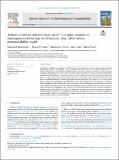| dc.description.abstract | Assessment of land-use and land-cover (LULC) change of any region is one of the prominent features used in
environmental resource management and its overall sustainable development. This study analyzed the LULC
changes of Ngorongoro Conservation Area (NCA) and its surroundings using Remote Sensing and Geographical
Information System integrated with Cellular Automata-Markov model. The LULC maps for the years 1995, 2005,
and 2016 were classified using unsupervised and supervised classification procedure, and projected for 2025 and
2035 under business-as-usual scenario using the CA–Markov model. The results indicated maximum gains and
losses in cultivated land and woodland in the study duration, respectively. The projected LULC for the period
2025 to 2035 showed a reduction in bushland, forest, water, and woodland, but an intensification in cultivated
land, grassland, bare land, and the built-up area. The natural forests with high environmental values were found
to be continuously declining under the current land management trend, causing the loss in the NCA’s ecological
values. For sustainable management, the authorities must reach conciliation between the existing LULC patterns
change and ecosystem services monitoring. A rational land use plan must be made to control the increase of
cultivated land and built-up area counting a rational land use plan and ecosystem services protection guidelines.
Decision makers should involve stakeholder to support improved land use management practices for balanced
and sustainable ecosystem services strategies. | en_US |

